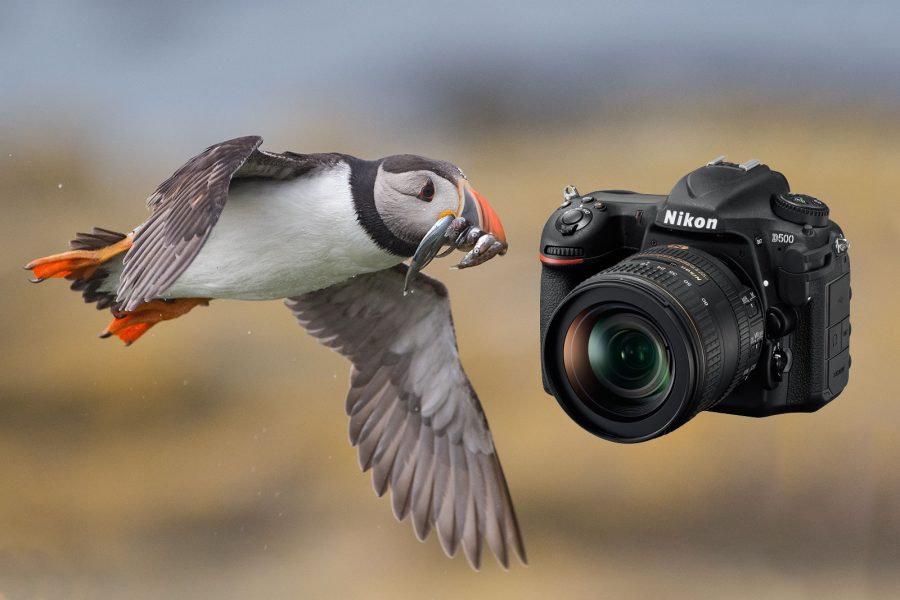Nikon D500 Review: In the Hands of a Wildlife Photographer

When new cameras arrive on the photography scene they are often surrounded by a fanfare of anticipation and hype, fuelled by the plethora of internet forums and rumour websites. In January 2016, Nikon announced their new APS-C (or DX) flagship model, the D500, successor to the venerable D300. It is fair to say the camera was very keenly anticipated, given Nikon’s six year hiatus from developing the pro-body DX range, but does it live up to the internet hype? Let’s find out!
Navigation: First Impressions | Specifications | Autofocus | Image Quality & ISO | Shooting Speed | Problems | Conclusion | Purchasing
First Impressions
Out of the box and into the hand there are a few changes which become quickly obvious, not just from the D300 but also from Nikon’s whole product line-up.l
Firstly, the remodelled grip is deeper and more acutely angled. If you are a big-handed oaf like myself, I think you’ll agree that this depth helps your grip on the camera feel a lot more secure and solid. Don’t worry if you are the opposite though, the more acute angle will benefit smaller hands too. Best of both worlds!
A surprising change from the veteran D300 predecessor is the inclusion of a circular eyepiece, previously reserved for Nikon’s top line and full frame (FX) range. Spectacle wearers may find this more useable than the rectangular eyepiece and the built-in viewfinder blind is handy for long exposures. From a rather selfish point of view I’m pleased to see this as it facilitates ongoing compatibility of FX accessories such as my right angled viewfinder and water covers. If you are upgrading from a camera with a rectangular style eyepiece you may not share my enthusiasm.
On first use, the viewfinder appears absolutely cavernous compared to previous DX models. This is thanks to the introduction of 100% coverage and 1.0x magnification, it looks big and bright and gives a full frame feel in use.
Another new addition is a touch sensitive tilting screen of the same general design implemented on the D750. I’ve always been quite negative about tilting and articulating screens. It’s not that I don’t see their benefits for being able to shoot with your camera at higher or lower angles, but I’m more concerned about how this may compromise the weather / dust sealing. The manual does include a vague warning about liquid contacting the inner surface and there is no rubber gasket sealing like we see around some lens mounts. On a positive note, the tilting mechanism feels a lot more robust than the D750 screen which is reassuring.

I’ve found the functions of the touch screen to be disappointingly limited. Unfortunately it can’t be used to quickly navigate the many menus and adjust the settings; this is still done using the direction pad and, where necessary, the ‘Ok’ button. In playback, the touchscreen allows a ‘flick’ action to cycle through images, a ‘stretch / pinch’ to zoom in and out and a ‘slide’ to move around a zoomed in image.
More benefits of the touch screen become apparent when using Live view for stills and movie, including touch screen focus and shutter, spot white balance and text entry.
It came as a surprise to see Nikon have abandoned the internal pop up flash. Outside the top of the range (e.g. D4, D5), it is only the second camera to drop this stalwart accessory – the retro style DF being the other. But my surprise is not because I find myself yearning for direct and flat looking artificial lighting which doesn’t clear many of my lenses. No, it is the loss of the very successful and brilliant built-in wireless flash commander system which has been replaced with a new wireless communication. The 100% / 1.0x viewfinder may also have influenced this decision too.
The XQD card format has also made its debut in the DX range. Compact Flash support has gone and instead we have a dual XQD and SD arrangement. There is no additional modular option for double XQD as marketed with the big brother D5.
More subtly, the mode button has been repositioned to the left, above the release mode dial, in place of the ISO button which now takes its place next to the shutter release and exposure compensation buttons. This move is aimed at grouping it with exposure compensation to make adjustments more efficient and intuitive by helping to negate the need to move your eye from the viewfinder. It takes a little getting used to at first but after a short while it becomes second nature. Unfortunately, Nikon have removed the ‘Easy ISO’ option which assigned one of the command dials to change the ISO without simultaneously pressing the ISO button.

The addition of a ‘joystick’ type of control coincides with the increase in selectable AF points. The more traditional direction pad is still present but the new joystick allows a much faster transition between AF points. It does take a little bit of practice to use precisely.

The D500 also introduces the glowing buttons, previously introduced on the D4, into the DX range. On rotating the power switch past ‘On’ to illuminate the top LCD monitor, the main rear controls also light up. Anybody working in dark conditions or dimly lit wildlife hides, for example, will appreciate this useful feature.

As we would expect, the D500 body and controls feel absolutely solid, just like a professional grade camera should do. Controls are well placed and custom buttons support a wide range of programmable functions.
The D500 is the first camera to include Nikon’s new SnapBridge technology. This allows photographers to establish and maintain a low energy Bluetooth connection with up to five smart devices. SnapBridge facilitates the automatic transfer of reduced size (2mb) JPEGs, embeds image information such as copyright contact details or watermarks, acts as a remote control with live view, synchronises GPS location and time to the camera, and allows sharing to social media and Nikon Image Space.
The required SnapBridge app is currently available for Android devices and the iOS version is expected later this year.
Specifications
The main D500 specifications competing to grab the headlines are the trailblazing 153-point autofocus system with 99 cross-type sensors – more detail on that later! Add 10 frames per second for the shutter rate and a huge 200 shot buffer for 14-bit lossless compressed raw files, and it is easy to see this camera is aimed squarely at action photographers.
There is little value in writing all of the specifications here when they are already available on so many retail websites. Instead I’ve listed those which I feel are of the most interest and also how they compare to the D300(s) predecessor and main competitor, the Canon 7d Mark II.
Autofocus
As a DSLR camera which is aimed at the action photographer, the D500’s AF system warrants a significant amount of scrutiny. It is worth starting this section by mentioning the D500 shares the same autofocus system with the top of the Nikon range, the D5. It means business!
They both offer an unprecedented 153 autofocus points, including 99 of the more accurate cross-type sensors. Of the 153 points, 55 are individually and manually selectable, 35 of these are cross-type. The remaining 98 AF points are interspersed around the selectable points. Numbers-wise, the AF system sounds very good, but numbers alone do not give the full picture.
Firstly, the DX (APS-C / crop) advantage. The reduced field of view compared to the FX (full frame) D5 means the D500 has edge to edge coverage of AF points. This brings an incredibly versatile level of compositional freedom without having to focus and recompose. With most f/4 (or faster) lenses, this includes the more accurate cross-type to the far left and right edges of the frame.
Let’s take a look using this representation:

- RED DOT: Cross-type AF sensor
- BLACK DOT: Ordinary AF sensor
- RED SQUARE: Selectable cross-type sensor
- BLACK SQUARE: Selectable ordinary sensor
It is important to note that the full availability of cross-type AF points is reduced when using lenses with smaller maximum apertures and teleconverters. The D500 user manual gives a very detailed breakdown of this availability with the range of Nikon lenses and I’ve included a link at the end of this review – go to page 98.
The additional 1.3x crop uses 117 focus points (45 selectable) of which 63 are cross-type (25 selectable).
AF Area Modes
There are 5 modes for configuring how the AF points work:
Auto Area – the camera automatically tries to determine focus.
Single Point – where 1 of the 55 selectable points can be selected using the new joystick or more traditional direction pad. The camera will only use this AF point to focus.
Dynamic Area – a single point can be selected as above, but the camera will dynamically utilise the surrounding 25, 72 or all 153 points if the subject moves from the original AF point.
Group – the camera focuses using a group of 5 points. You’ll only see 4 activated in the viewfinder as the central one remains hidden. The camera will attempt to focus on the nearest part of the subject within these 5 points.
3D Tracking – A single point can be selected and the camera then tracks the subject around the frame.
Focus Tracking with Lock-on
A new 3 stage ‘Subject motion’ setting from Erratic to ‘Steady’ is included in the ‘Focus Tracking With Lock On’ setting. The traditional setting is now labelled on a scale of 1-5, where 1 is quick and 5 is delayed.
AF in Practice
Over the last few weeks I’ve been using the D500 exclusively on my regular trips to Northumberland’s Farne Islands. For a wildlife photographer keen to photograph some birds in flight and relishing the challenge of those little Exocet missiles, also known as Atlantic Puffins, the Farne Islands provide the perfect opportunity.

I’m not going to go into detail about the single point mode. As you would expect, I’ve found this to be consistently the most accurate mode for static subjects or something moving slowly and predictably enough to maintain correct AF point placement. Nothing really changes here from other cameras with advanced and customisable AF settings so let’s look at where the real magic happens!
For panning with, and tracking a moving subject the D500’s Dynamic Area and Group settings are the most appropriate AF modes to use. On the basis of familiarity, I opted to begin with the Dynamic settings. This is where you acquire focus using a single point and the surrounding points are used dynamically to share information if (or when!) the subject moves away from this single point. Previously the Nikon cameras at the top end of the market had 51 AF points with the ability to use 9, 21 or 51 points dynamically. The D500 crams in so many AF points in such a tight spacing we can now use 25, 72 or 153.
I’ve spent many years photographing puffins in flight on the Farne Islands and enjoyed a good success rate using a combination of appropriate camera settings and fieldcraft. Transferring this existing knowledge and set up to the Nikon D500 has left me absolutely gobsmacked at the speed, responsiveness and tracking ability of this camera. It is simply incredible at finding and maintaining focus on the subject, even with a high contrast background. Throughout my testing I used a combination of 25 and 72 points dynamically and in terms of focus the D500 simply hit the spot over and over again.


It is without doubt the most effective autofocus system I have ever used in a camera. It increased my consistency of in focus shots, even with shot over shot in the same run of many frames per second. Incredible!
Image Quality
It’s easy to get carried away with the phenomenal AF of this camera but let’s not forget something more crucial: image quality.
Looking at the wider Nikon range I expected to see a 24 megapixel sensor when the D500 was announced, so I was a little surprised to see 20.9mp (5568px x 3712px). But as we’ve already established, this is a camera aimed at action photographers where speed is of the essence. For their DX range, this is clearly Nikon’s current limit while maintaining high ISO quality and processing speed for frames per second and buffering. Wildlife photographers often like to crop, so four megapixels less than older cameras in their range does sound quite a large drop, but in reality it is less than 500 pixels in overall image size on the longer side of the frame.
Overall, I’d say the image quality of the D500 is as good as other class leading comparable models. Admittedly that sounds a little vague or even under-whelming, but where the Nikon D500 shines is that this high quality is maintained despite the huge differences in the high speed shooting ability when compared to its competitors.
ISO Capabilities
The high ISO performance of the D500 is the element of image quality which is worthy of as much scrutiny as the AF system. The native ISO range is between 100 to 51,200 and is further expandable between 50 and 1,640,000.

Rather than opting for a test chart in a studio, I’ve tried to keep this test a little more fun and also practical. I wanted something which would represent a typical wildlife photography subject but wouldn’t move in between frames. Not easy! So, I acquired a taxidermy specimen of a puffin from Newcastle’s Great North Museum. Check out that stick-on eyeball!
These test shots were all photographed on a tripod at f/8 using a Nikon 200-400 f/4 lens. No raw processing or noise reduction has been applied.
As you can see the D500 is doing a great job of capturing fine detail at high ISO and noise isn’t much of an issue until ISO 6,400. Gone is the ugly and ‘blotchy’ colour noise of its predecessor, the D300. Instead the noise is more like a uniform grain which is well dealt with in software. For real world use I have no problem using the D500 up to ISO 5,000 when necessary. As above, it’s incredible for an APS-C sensor with such high speed shooting.
Shooting Speeds
Most of my work over the last 3 years has been done using a Nikon D800 with a rather pedestrian 4 frames per second. Regardless of any camera I have used, I have never been a machine gunning type of photographer. But since I picked up the Nikon D500 the reality of how much I have missed a faster frame rate has really become apparent to me, I now have 10 frames per second at my disposal. In itself that is no big deal, it matches the standard set by the competition – Canon’s 7d Mk2.

However, another area where the Nikon D500 excels is in the buffer. When photographing using lossless compressed raw files, you can maintain 10 frames per second for an incredible 20 seconds before the camera slows down. That is an incredible 200 shot buffer.

I rarely shoot at this rate for such a prolonged period of time; for me the advantage of a 10 frames per second camera is a very quick burst of 5-6 frames in half a second. I haven’t yet unleashed the 20 second / 200 shot buffer in any meaningful photography situation.
Such a fast and versatile frame rate isn’t all beer and sandwiches in the park though; it does come with a drawback. If you want to use the camera to its full advantage, you’ll need to invest in some rather expensive, fast XQD cards. You’ll also need some pretty fast SD cards too. Another issue is the noise of the shutter and mirror slap. In the peace and quiet of a wildlife hide it sometimes feels like I’m firing a machine gun! There is a ‘quiet’ burst mode but I don’t think it is significantly different, and it also reduces the frame rate to 3 frames per second.
Problems?
As I write this review I’m not aware of any major issues that have come to light, but there are a few minor post-release issues you may wish to be aware of. I haven’t personally experienced any of the first group of issues but you may wish to investigate them if you suspect they are relevant to your current equipment.
- Users of some Sigma and Tamron lenses may experience issues with focusing in live view.
- SnapBridge is not yet available for iOS.
- Lexar 1000x and 2000x SD card failures.
- Third party battery failure.
Unfortunately, I have experienced issues surrounding the battery life using Nikon’s own EN-EL15 and can elaborate further. Firstly, it is important to note there are two versions of the EN-EL15, the Li-ion1 and Li-ion20. The latter is shipped with the D500 and the other with cameras such as the D7200 and D800.
The first issue was when using the camera for the first time using the supplied Li-ion20 battery. After about 15-20 minutes of setting the camera up (and not even taking a shot) the camera indicated about 50% of the charge had been used. One possible reason was the camera looking for bluetooth connections, but I had turned ‘Airplane Mode’ On so all communications were actually disabled.
This continued for around 4-5 charge cycles of the battery and each time there was very poor longevity of the battery. I researched two possible and plausible solutions:
- The battery needs a few full charge cycles to reach its full potential
- The camera’s internal battery takes an unusually long time to reach capacity and drains the main battery quickly to achieve this.
It has since resolved itself and I happy I am getting the expected rating for battery life using the supplied Li-ion20 version of the battery. In conclusion, well I don’t know! But don’t worry if you experience the same issues as it appears to resolve itself, just make sure your battery or camera is working to its optimum level before using the D500 on anything important.
The second issue is with older versions of the EN-EL15, marked Li-ion1. You are likely to have these if you have a camera such as the D7200 or D800. With these batteries there is a significantly shorter battery life than the supplied Li-ion20 as well as an inconsistency in displaying the available charge of a battery across different compatible cameras.
Nikon are offering all D500 users who have existing Li-ion1 batteries free replacement Li-ion20 versions. Information is available via Nikon support websites.

Conclusion
What is amazing:
- Ergonomics and handling, primarily the joystick type control and new placement of the ISO button.
- For tracking action it is phenomenally accurate and more consistent than any other camera I have used.
- Autofocus points covering a huge area of the frame.
- Frame rate and buffer.
- Excellent all-round image quality at high ISO.
Before I list what I don’t like I need to introduce a caveat! This is such an amazing camera my dislikes are quite personal and subjective based upon my own style of shooting.
What I don’t really like:
- The tilt screen, mainly because I feel it is a weak point in terms of weather sealing.
- Not being able to use the touch screen to change settings.
- Noisy mirror and shutter slap.
- Battery problems.
- Loss of previous wireless flash control.
It has been a long time coming, but at last Nikon have provided the camera so many photographers have wanted. A high speed, high performing camera for those of us in an action orientated genre. It’s not a budget camera by any means, but given the features and performance it shares with its big brother the D5, it is fair to say that it still represents very good value.
Put simply, this is the best APS-C camera currently available on the market. That’s quite a bold statement to make but it demonstrates how impressed I am with this camera.
You can read the D500 manual here.
Thank you to the Great North Museum: Hancock, for the loan of the puffin!
Purchasing Options
Looking to get your hands on a Nikon D500 yourself? I’m not surprised. You can get the camera from the following trusted retailers:








